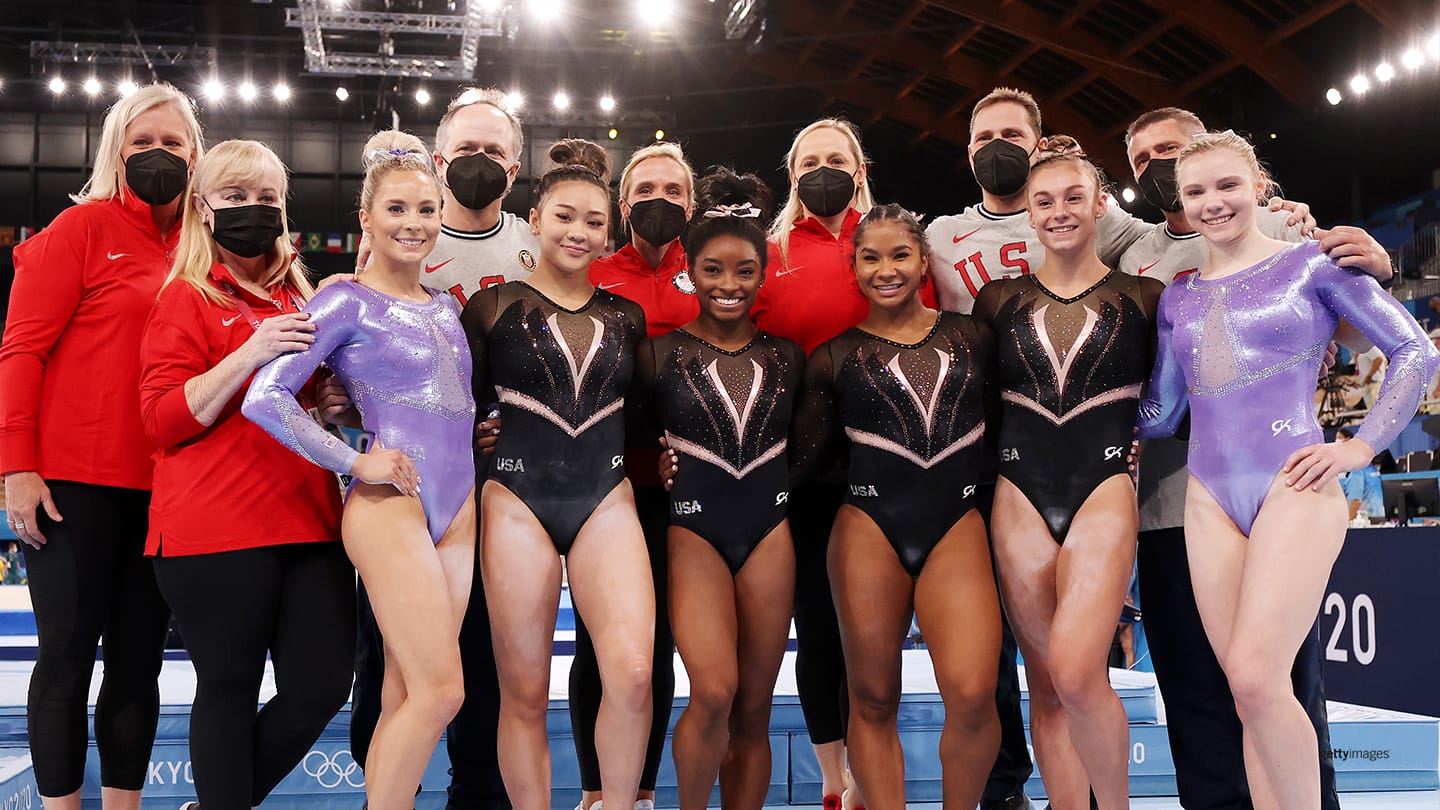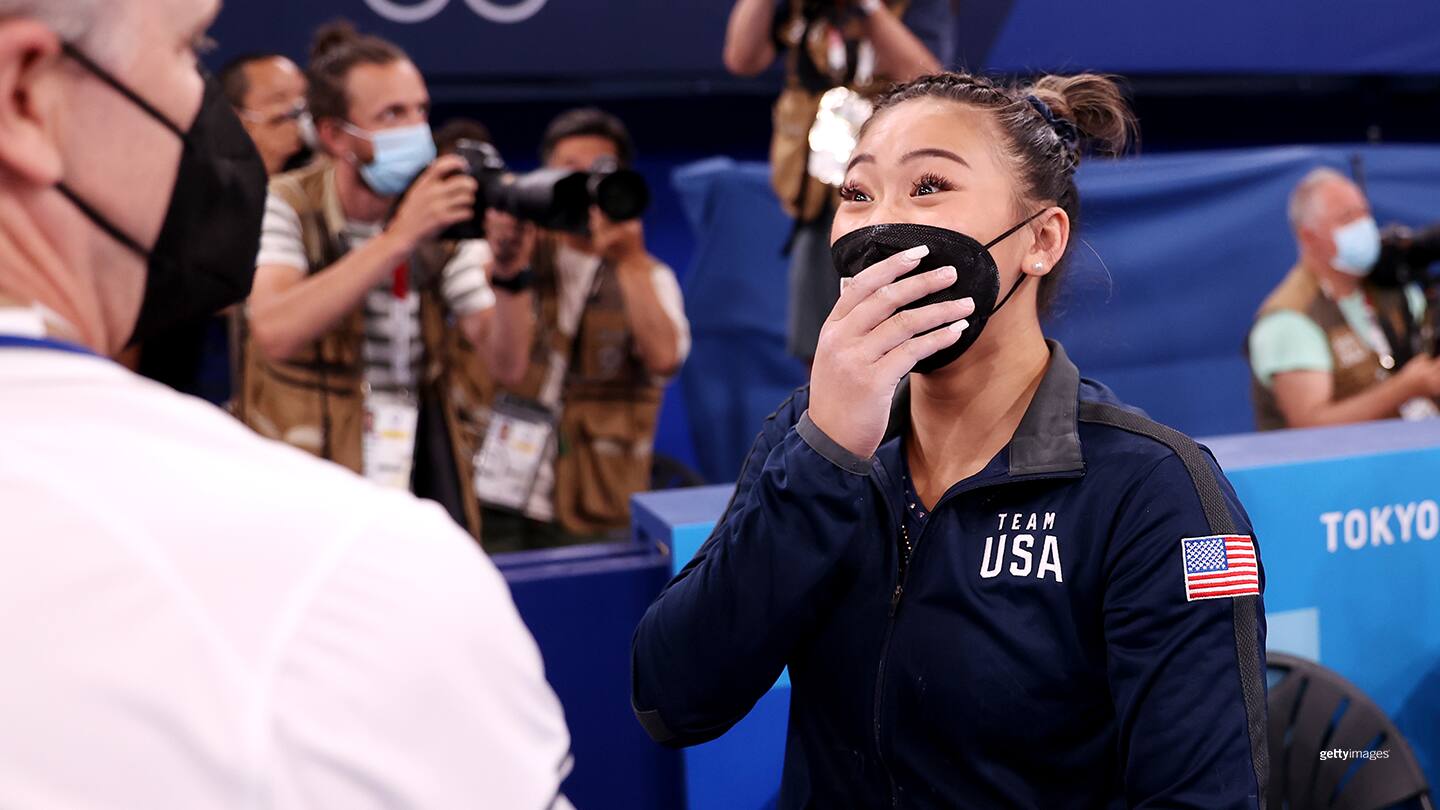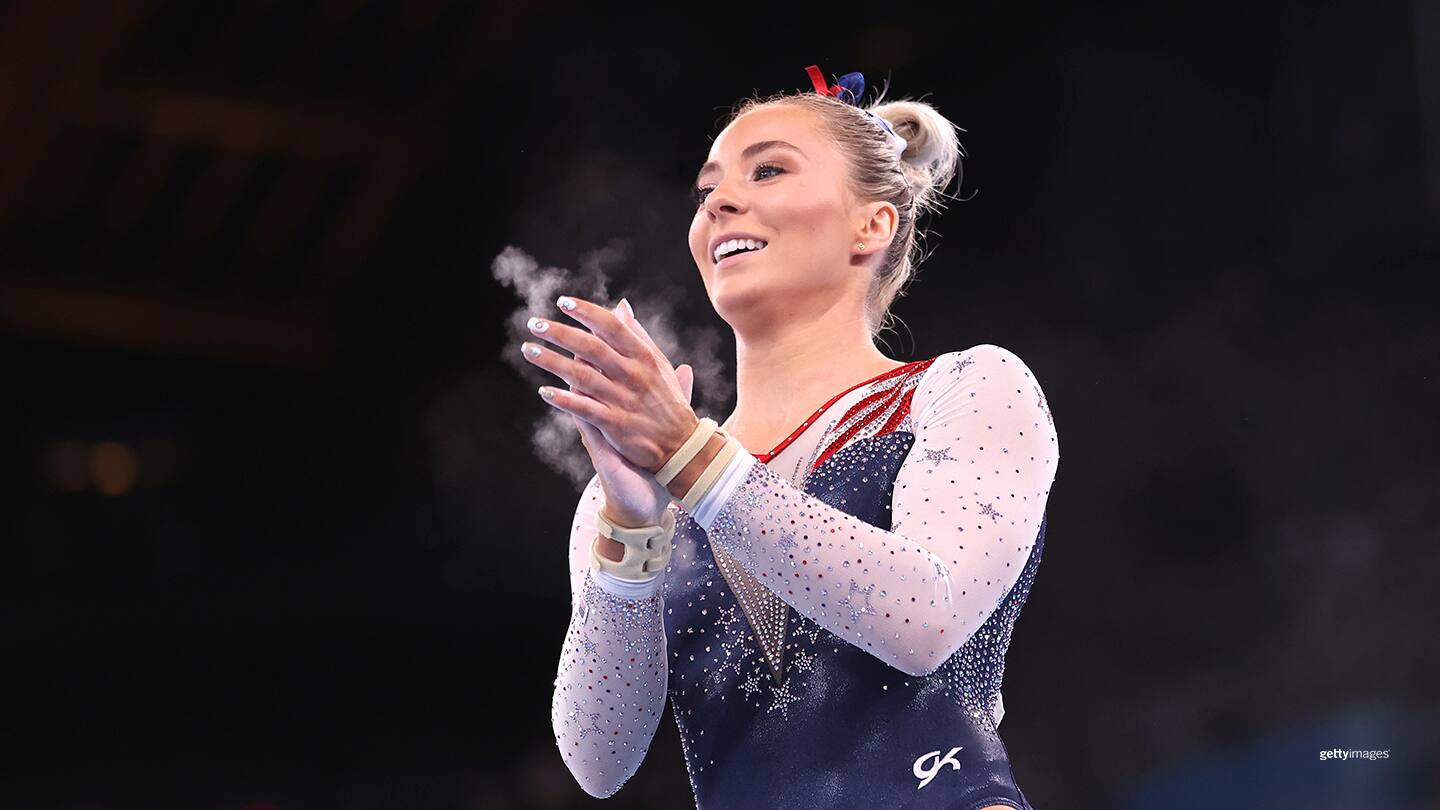
What To Watch As U.S. Olympic Gymnasts Turn Their Focus To College
by Blythe Lawrence

The U.S. women's artistic gymnastics team poses ahead of the Olympic Games Tokyo 2020 on July 22, 2021 in Tokyo.
For college gymnastics fans, the end of an Olympic Games means one thing: the elites are coming.
At the end of each Olympic quad, a new generation of elite women’s gymnasts who had been holding out for the Games turns their attention to the college ranks. This coming season — which begins in earnest next month — is no exception.
That includes four of the six gymnasts who represented Team USA this past summer at the Olympic Games Tokyo 2020.
Forever united by what they accomplished on the Olympic stage, Suni Lee, Jordan Chiles, Jade Carey and Grace McCallum have chosen different universities as they pursue higher education and further glory.
That means — for the next few years, anyway — competing against each other.
The transition from elite gymnastics, where expression can seem stilted in routines loaded to the gills with difficulty, to the more show-it-off NCAA, where execution trumps difficulty, can be a challenge for first-years, though this year’s class may prove ahead of the curve. Many of the biggest names of the incoming women’s crop spent the fall on Simone Biles’ “Gold Over America” tour, criss-crossing the country performing in packed arenas from Arizona to Boston.
Here’s a look at five programs about to get an injection of talent from former U.S. national team members.

Sunisa Lee celebrates winning bronze in the women's uneven bar finals at the Olympic Games Tokyo 2020 on Aug. 1, 2021 in Tokyo.
Auburn
Lee proved to be the breakout star for Team USA in Tokyo. Already the first Hmong American to make a U.S. Olympic Team, the Minnesota teenager became the fifth consecutive U.S. woman to capture the Olympic all-around gold. She also played a key role in the team’s silver medal, then wrapped up the Games with a bronze medal on the uneven bars.
Now she’s taking her star power south, where she becomes the first Olympic gymnast to select Auburn. An instant-impact freshman, Lee will be an essential part of a War Eagle squad led by a familiar face: Jeff Graba, the twin brother of her Minnesota club coach Jess Graba.
Though Lee, 18, did not take part in the post-Olympic tour, she did briefly trade her grips for ballroom dance shoes on “Dancing with the Stars,” where she and partner Sasha Farber finished fourth. If her Olympic results are any indication, Lee will fare even better in the NCAA.
Oregon State
Carey becomes the first Olympic floor exercise champion to partake in NCAA gymnastics, where the most expressive routines from the past few years have often gone viral online, giving rise to celebrity shout-outs and internet fame.
Like Lee, she’s doing so outside of the sport’s usual power structure. The 21-year-old Arizonan committed to Oregon State in 2017, then deferred while traveling the globe to compete at world cup events in her bid for an individual specialist spot to the Tokyo Games. With the golden ticket mathematically hers by the time the pandemic hit, Carey took advantage of the pandemic year to take online classes and has already decided to major in kinesiology.
UCLA
A program that’s no stranger to star power is adding some more.
Chiles, whose clutch performances on uneven bars and balance beam helped the U.S. team clinch the silver after Biles’ surprise withdrawal, recently arrived at UCLA, where she wowed at her first practice by executing a double-twisting Yurchenko vault, a rare and valuable skill in the NCAA.
With U.S. Olympic gold medalists Kyla Ross and Madison Kocian now having wrapped up their careers in Westwood, Chiles is part of a new generation of former elite stars. She’s joined in a loaded freshman class by Olympic alternate Emma Malabuyo, as well as two top Canadians: 2020 Olympian Brooklyn Moors, and 2018 world championships balance beam silver medalist Ana Padurariu. They’ll hope to return the Bruins to the championship form the team last displayed in 2018.
Top-flight recruits are UCLA’s not-so-secret weapon. Less well known is BJ Das, the team choreographer responsible for many of those viral floor routines. Could Chiles, 20, be next?

Mykayla Skinner competes in the women's vault final at the Olympic Games Tokyo 2020 on Aug. 1, 2021 in Tokyo.
Utah
MyKayla Skinner made a name for herself in Utah before returning to elite gymnastics, making the U.S. Olympic team as an individual specialist and then winning a silver medal on vault. She’s left the college ranks behind, but the Red Rocks are quickly replenishing their star power.
The 19-year-old McCallum, who served as tablesetter for Team USA in Tokyo, selected Utah, where she will compete alongside Tokyo 2020 alternate Kara Eaker, a two-time world championships finalist on beam. Amelie Morgan, who helped Great Britain win team bronze in Tokyo, joins them too. All three will help fill the hole left by Skinner, who competed for Utah for three years and decided to turn pro following the Games.
Florida
Star power extend beyond the Olympians. Florida has landed a trio of all-star recruits in Tokyo 2020 alternate Leanne Wong, Riley McCusker and Morgan Hurd. These Gators chomp hard: Wong, who spent her time in Tokyo in quarantine after training partner Eaker contracted COVID-19, returned to Japan to claim all-around silver and floor bronze at October’s world championships. McCusker has swoon-worthy swing on uneven bars. Hurd is the 2017 world all-around champion who has espoused social activism. She is expected to be added to the roster in January.
Arkansas
If you’re looking for Olympic connections in the coaching staff, turn your attention to Fayetteville. Arkansas, helmed by 2012 Olympic gold medalist Jordyn Wieber and her fiancé, 2016 Olympic team member Chris Brooks, and assisted by Wieber’s London 2012 teammate and former UCLA star Kyla Ross, is a program to watch out for.
What To Watch For This Season
Scattering the Olympians among top universities adds increased parity to NCAA gymnastics, which for years was dominated by Georgia, Alabama, Utah and UCLA. All remain powerhouses, but in the past decade several other universities — Oklahoma, Florida, LSU and Cal, among others — have overtaken the old school guard.
Yet anyone who watched the Olympics this summer is cognizant that the best laid plans in gymnastics don’t always work out. Case in point: Michigan’s rise to conquer all at the NCAA championships last spring. Led by senior Natalie Wojick, the hungry Wolverines are returning all but two members of their championship team and are likely to remain a force this year too.
What About The Men?
The U.S. men’s team, populated by NCAA athletes, has been demoralized by the dwindling number of universities that offer the sport. That also means that the best, including current U.S. champion Brody Malone and Tokyo 2020 alternate Brandon Briones, are distributed among a small number of top schools.
Reigning NCAA champion Stanford is set to renew its intense rivalry with 2021 runner up Oklahoma and Michigan in January. All three boast impressive prospects: Malone and Briones both compete for Stanford, while Olympic alternate Cameron Bock is now a senior at Michigan. Wolverine junior Paul Juda’s impressive performance at the 2021 Pan American Championships earned the U.S. the right to send an extra gymnast to the Olympics. The always deep Oklahoma will get a boost with the arrival of top junior Aydon “Fuzzy” Benas.
Blythe Lawrence has covered three Olympic Games and is a freelance contributor to TeamUSA.org on behalf of Red Line Editorial, Inc. Follow her on Twitter @rockergymnastix.